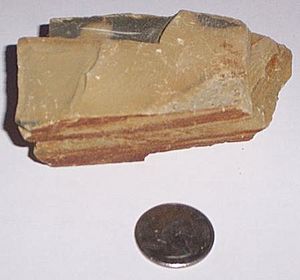Martinsburg Formation facts for kids
Quick facts for kids Martinsburg FormationStratigraphic range: Late Ordovician |
|
|---|---|

A sample of the Martinsburg shale from the Pennsylvania Turnpike (Northeast Extension) at mile post 66.
|
|
| Type | Formation |
| Underlies | Juniata Formation |
| Overlies | Jacksonburg Limestone and Utica Shale |
| Location | |
| Region | Virginia and West Virginia |
| Country | United States |
The Martinsburg Formation is a type of rock found in several states like Pennsylvania, New Jersey, Maryland, Virginia, and West Virginia. It's named after Martinsburg, West Virginia, where it was first studied. This rock formation is very common in the Great Appalachian Valley, especially in places like the Kittatinny Valley in New Jersey and the Lehigh Valley in Pennsylvania.
Contents
What is the Martinsburg Formation?
The Martinsburg Formation is mostly made of gray to dark gray shale and slate. Sometimes, you might see it in tan or purple colors too. You can also find other types of rock within it, like sandstone, thin limestone (which is a rock made from tiny sea creatures), or even phyllite (a type of metamorphic rock). These different rocks are found in areas like the Cumberland Valley and the Lehigh Valley.
Different Parts of the Martinsburg Formation
In the Lehigh Valley, the Martinsburg Formation is split into three main parts:
- The Bushkill Member is the lowest layer, mostly made of slate.
- The Ramseyburg Member has layers of sandstone mixed with shale and siltstone. These layers were formed by underwater landslides.
- The Pen Argyl Member is the top layer, mostly slate with some phyllite and shale.
How Did the Martinsburg Formation Form?
The shales and slates of the Martinsburg Formation were laid down in a huge, deep ocean basin. This basin formed as the ancient Iapetus Ocean slowly closed up. Imagine a giant underwater valley where sediments collected.
Understanding Turbidites
You might find "turbidites" in the Martinsburg Formation. These are special layers of rock formed by underwater landslides. When a lot of mud and sand slides down a steep underwater slope, it creates a fast-moving cloud of sediment. When this cloud settles, it forms a turbidite layer. This is similar to how sediments are deposited today between Australia and East Timor.
What Fossils Are Found in the Martinsburg Formation?
Many interesting fossils have been discovered in the Martinsburg Formation.
- In the Pen Argyl Member, you can find Graptolites (tiny sea creatures that looked like saw blades) and Conodonts (small, tooth-like fossils).
- In the Swatara Gap area, you might find Trilobites, especially a type called Cryptolithus. Trilobites were ancient sea creatures with hard shells.
- You can also find Protasterina, which was a type of brittle star, similar to a starfish.
When Did the Martinsburg Formation Form?
The Martinsburg Formation was formed during the Ordovician period, a very long time ago! This was between 457 and 445 million years ago. To give you an idea, that's long before dinosaurs roamed the Earth.
Near Hamburg, PA, there's a special section of rocks called the Hamburg klippe. These rocks are older and were moved on top of the Martinsburg Formation by powerful forces in the Earth.
The Martinsburg Formation sits between other rock layers. For example, the Shawangunk Formation, Kittatinny Formation, Tuscarora Formation, and Juniata Formation are found above it. Below it, you might find the Chambersburg Formation and Myerstown Formation.
How Is the Martinsburg Formation Used Today?
The rocks from the Martinsburg Formation are still very useful!
- Slate is quarried (mined) from this formation in Pennsylvania. Slate is a strong, flat rock often used for roofing tiles, floor tiles, and even blackboards.
- Other parts of the shale are used as crushed stone. This crushed rock is used in construction for things like building foundations, roads, and other earth-filling projects.

